
Pairing Pink Flowers
How to combine pink in the garden?
Contents
Pink flowers create charming scenes in a garden. This soft and romantic colour allows for relatively easy combinations with many other colours. To avoid a candy box effect, it is recommended to pair the flowering of pink perennials or bushes with similar shades such as mauve or blue, pastel apricot tones, or even white, and for the brightest pinks, with orange hues. Foliage should be combined in the same way, using cool tones, greys or purples, or zesty greens, depending on the desired atmosphere.
What are the most beautiful combinations with pink flowers? How can you avoid an excess of pink and balance a flowerbed for soft or more contrasting effects? Follow our tips to successfully create your scenes according to the seasons and your type of garden.

Pink pairs more or less well with other colours…
Pink in the Garden
- Pink is part of the cool colours in the colour wheel… but this is nuanced, as this colour is derived from a mixture of red and white, which tempers the cool aspect.
- The colour pink is the most widely found in flowers! The palette of pink flowering is impressive: warm pinks, rich and vibrant, pigmented with red or orange, to cooler pinks tinged with blue or mauve, including salmon pinks, not to mention pale pinks, very pastel, evoking softness, favoured by romantic gardeners, and bicoloured pink and white flowers. Each of these shades pairs particularly well with distinct colours.
- We love the delicacy of pink, but if used improperly or over a large area, it can convey a cloying aspect that detracts a bit from the garden’s personality… hence the importance of judiciously pairing it with other colours, as well as with extravagant, contrasting foliage or, conversely, very light foliage to spice up and lighten the scenes.
- Light plays a significant role in our perception of pink: a pink flower illuminated by the late afternoon sun will appear much warmer than the same flower planted in a shady area. Exposure zones should therefore be considered in advance, depending on whether the pinks are cool or warm.
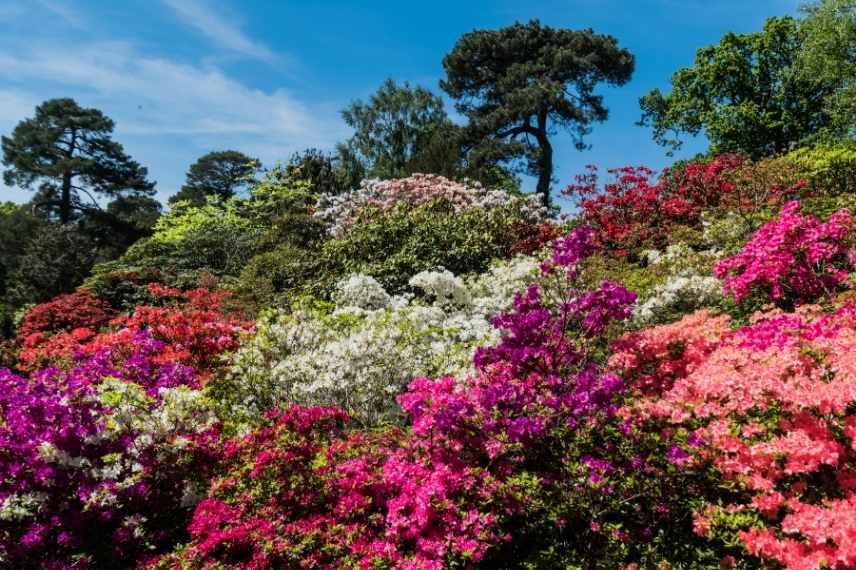 Pink flowers from heather soil shrubs pair very well together in gradients of pink and purple
Pink flowers from heather soil shrubs pair very well together in gradients of pink and purple
Read also
9 pink-flowered perennialsPairing Pink Flowers in a Monochrome Garden
Just like in the blue garden, it is useful to lighten your key colour to enhance it, as too much pink will ultimately detract from the overall effect. In the pink garden, a few distinct colours will awaken an excess of pink, without straying too far to maintain a monochrome theme.
We therefore favour nearby colours, such as mauve and purple shades tinged with red, or apricot. Also play with bicoloured pink flowers, often tinged with white. White flowers are necessary in touches to provide cohesion and revive the cooler pinks. Finally, foliage will play a major role as usual in lightening the overall effect or boosting it with large leaves, and in providing enveloping greenery.
→ Learn more in our advice sheet: Designing a pink garden

A few white foxgloves, white roses, and mauve Alliums blend perfectly with the pink dominance of this garden
Discover other Pink flowering perennials
View all →Available in 0 sizes
Available in 1 sizes
Available in 1 sizes
Available in 1 sizes
Available in 1 sizes
Available in 1 sizes
Available in 2 sizes
Available in 1 sizes
Available in 1 sizes
Available in 1 sizes
Pairing pink flowers with other colours
Several colours pair well with pink, particularly blue, pink and peach shades, yellow, and… green. For the first two colours, it’s really a matter of balance that must be respected, ensuring that neither flowering overshadows the other, while always keeping in mind a principle of harmony, in colour gradients.
When deciding to combine pink flowers with other shades, you can do so in bicolour scenes for very contemporary atmospheres, or in scattered splashes of colour in more abundant scenes:
- With white: Pink and white pair wonderfully, very naturally. This is a very fresh combination that works with both cool and warm pinks. White instantly brightens, especially in shadier areas. However, it should be avoided with very pale pinks or reserved for small spaces, as this combination can appear rather flat.
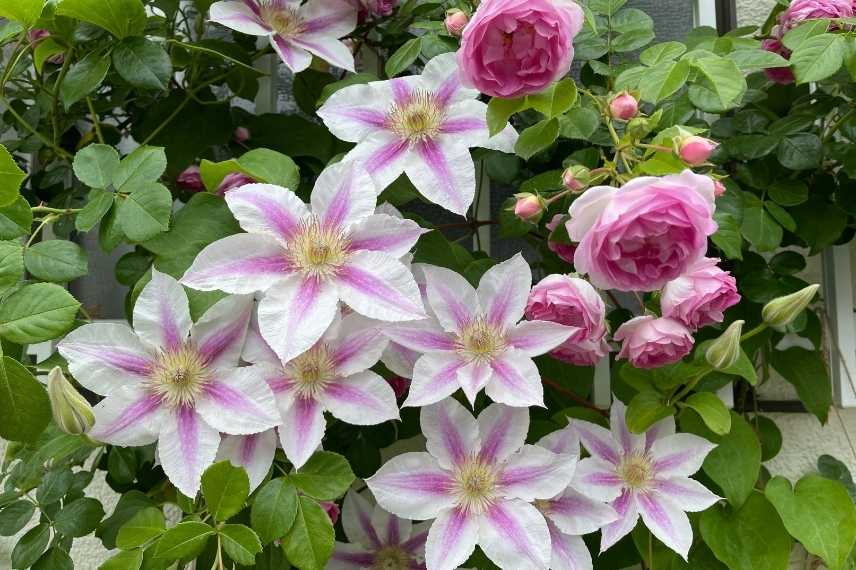 A timeless duo of pink and white!
A timeless duo of pink and white!
- With blue, mauve, or violet: This is another happy pairing, quite classic and often used in the height of summer when many flowers can lend themselves to it. These two cool colours will be enhanced by bright or light foliage that will prevent this duo from appearing too gloomy. Also consider using bicolour pink flowers to brighten the whole. The magical duo of blue clematis and roses is a perfect example.
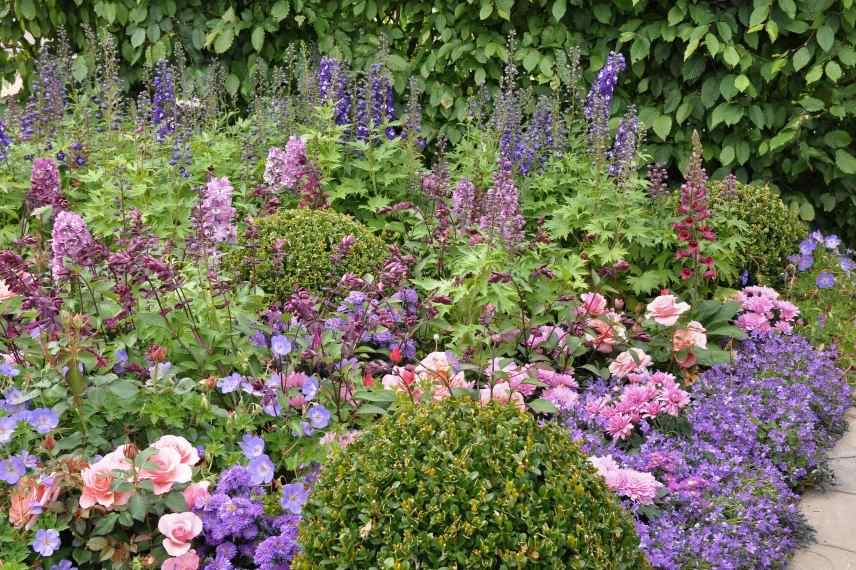 A beautiful composition of slightly salmon-pink roses, dwarf pink dahlias, pink foxgloves, violet campanulas, delphiniums, and blue ‘Suzanne’ geraniums with trimmed boxwood.
A beautiful composition of slightly salmon-pink roses, dwarf pink dahlias, pink foxgloves, violet campanulas, delphiniums, and blue ‘Suzanne’ geraniums with trimmed boxwood.
- With purple… or black: Here’s a duo with a strong personality, playing on contrast, which allows for very beautiful scenes when choosing warm roses, pigmented with yellow or orange, in coral or Indian pink shades, or pale roses. Too cool (too blue) roses will create a sad atmosphere. Purple can be expressed in flowering or foliage, just like black. Again, light foliage brightens the whole.
 A charming spring scene with Sambucus nigra ‘Black Lace’, Pittosporum tenuifolium ‘Variegatum’, some Carex Evercream, Kolkwitzia amabilis, and Physocarpus opulifolius ‘Diablo’.
A charming spring scene with Sambucus nigra ‘Black Lace’, Pittosporum tenuifolium ‘Variegatum’, some Carex Evercream, Kolkwitzia amabilis, and Physocarpus opulifolius ‘Diablo’.
- With orange: This may seem a bit daring, but the result is truly enchanting. The proof is in the image with the bicolour inflorescences of certain Digiplexis and avens… these two colours are made to go together! You create exotic or very vibrant scenes, a vibrant “Bollywood” or haute couture effect… The pink flowers should be chosen from warm pinks.
 Geum ‘Cocktail Wet Kiss’, Phormium ‘Rainbow Maiden’, Salvia ‘Ribambelle’, and Digiplexis ‘Illumination flame’.
Geum ‘Cocktail Wet Kiss’, Phormium ‘Rainbow Maiden’, Salvia ‘Ribambelle’, and Digiplexis ‘Illumination flame’.
- With anise greens: Here’s another combination that highlights pink flowers beautifully, providing a very fresh backdrop, like that of lady’s mantle, grasses, or euphorbias for the foliage. Some green flowers like those of clematis ‘Green Passion’ pair delightfully with roses or honeysuckles, while green and cream tulips also work wonderfully with pink bulbous and perennial flowers!
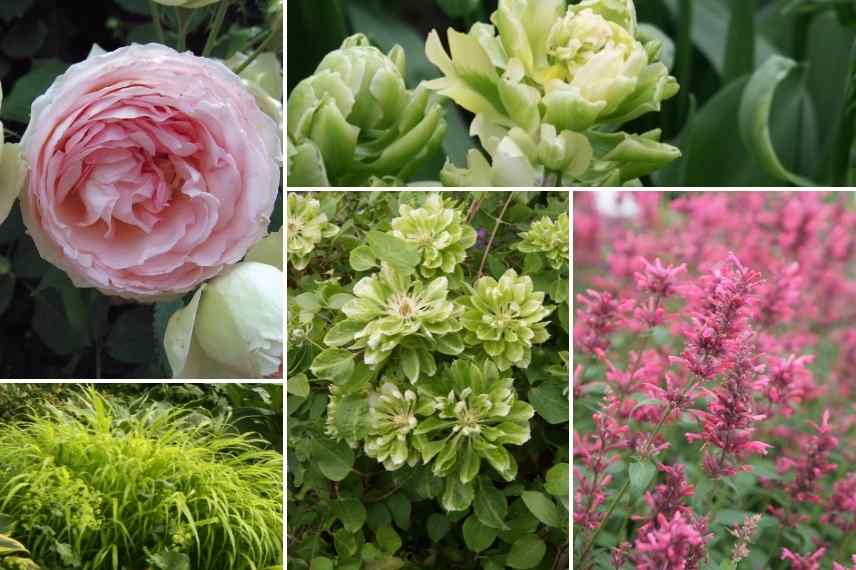 Rose Pierre de Ronsard, Tulip Brooklyn, Hakonechloa macra, Clematis ‘Green Passion’, and Agastache ‘Red Fortune’.
Rose Pierre de Ronsard, Tulip Brooklyn, Hakonechloa macra, Clematis ‘Green Passion’, and Agastache ‘Red Fortune’.
In large spaces, like a flowering meadow
These are areas where it is possible to combine pink flowers with many colours, particularly yellow. Overall, in large naturalistic gardens or large beds, pink flowers benefit from being lost in a myriad of colours for a wild effect. You can mix light or bright pinks for a more vibrant atmosphere.

In a country or cottage garden
Here again, more varied combinations are possible, taking care not to diversify the arrangements with more than four colours. Below, red, orange, and yellow roses blend in a country-style jumble, especially as dahlias serve as the main motif.

Read also
7 climbing flowers in pinkPairing pink flowers with foliage
Foliage plays a significant role in your pink flower arrangements, providing the volume and lushness often needed in garden scenes.
Foliage creates a very soft harmony when chosen in grey and silver tones (lavender, rosemary, Teucrium, helichrysum, etc.): pink flowers are then typically chosen in light, even pale, or salmon shades for a very soft and harmonious effect.
Purple and bronze foliage also pairs very well with pink flowers: they break the overly demure aspect of pink and warm up the overall look. Conversely, chartreuse green foliage also works well with pink flowers for refreshing atmospheres, often reminiscent of spring.
Finally, the fiery foliage of autumn, in yellow-orange hues, is stunning when paired with violet-pink Asters, Hydrangeas, or Callicarpas. The soft light in autumn allows for a play with these golden tones, revealed at the end of the day.

Oleander, Cotinus, Prunus ‘Kiku Shidare Sakura’, Lychnis coronaria, Stachys, Pieris ‘Valley Valentine’, and Euphorbia myrsinites
Pairing pink flowers to match your garden style
Pink flowers are not just the hallmark of the romantic garden. While they certainly thrive there, they can also be combined with pink blooms in various garden styles, always adding a touch of delicacy, regardless of the colour intensity. They particularly shine in the following gardens:
The English or Cottage Garden
Pink flowers express themselves beautifully here, mixed with many other colours, creating a delightful chaos and abundance of vegetation that is nonetheless orderly. Flourishing in mixed borders or climbing over arches and arbours, roses, clematis, peonies, Deutzias, foxgloves, Phlox, and sages mingle with lush foliage and either trimmed or soft bushes. The colour combinations are truly numerous: pink, white, mauve, pink and purple, apricot pink and white… as long as the visual harmony is present. Astrantias combined with hostas and lady’s mantle, Peonies alongside Oriental poppies and lupins… almost anything goes in the English garden… Pay particular attention to your perennial beds in the spirit of mixed borders, favouring arching and sprawling habits, and create romantic arches where fragrant roses and opulent clematis intertwine.
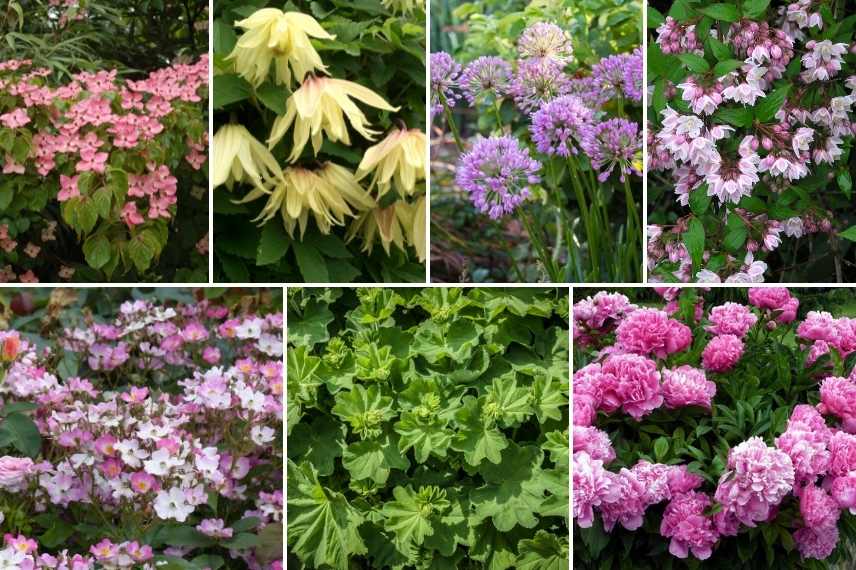
Cornus kousa ‘Satomi’, Clematis koreana ‘Amber’, alliums millenium, Old rose ballerina, Alchemilla mollis, and Chinese peonies
The Romantic Garden or Rose Garden
Of course, pink flowers are the queens of the romantic garden. This garden is halfway between the English garden and the country garden, with a preference for fragrant passages under arbours or pergolas… You will favour soft roses and pastel tones combined with very gentle mauves, and flowers in cream or pale yellow.

Penstemon ‘Strawberry and Cream’, Wisteria, Bonica rose, climbing rose on an arch, and clematis viticella ‘Little Nell’
The Country Garden
Softness and natural abundance meet in this unpretentious garden, where you will plant a mass of chosen plants from climbers, perennials, and deciduous and evergreen shrubs: honeysuckles, roses, Deutzias, sweet peas, lilacs, Alcea rosea (hollyhock), pink or white spireas, Physocarpus and elderberries, lupins, multicoloured cosmos, chrysanthemums, hardy geraniums, Crataegus in a deep pink (hawthorn). Pale pink flowers mingle with brighter pinks, white and mauve flowers, and a whole host of grey, purple, or green foliage, as well as grasses with more yellow tones. The expanse of a country garden truly allows for mixing several flower colours, but also for creating more intimate sub-spaces as in this lovely scene.
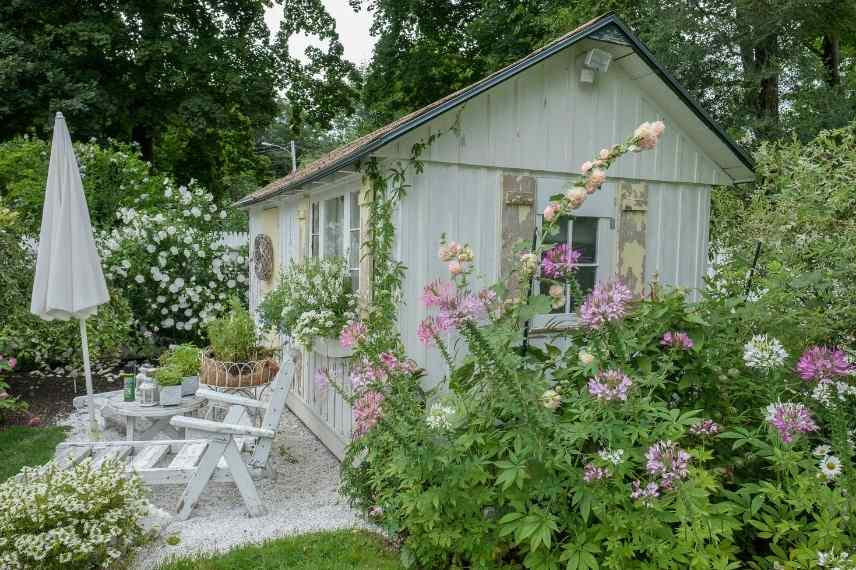
White roses, cleomes, and hollyhocks around a charming shed
The Japanese Garden
Graceful pink blooms are the perfect companions in a Japanese-style garden in spring, bringing their extreme delicacy: a wide range of azaleas and rhododendrons, Magnolia soulangeana, Chaenomeles (Japanese quince), ornamental Prunus, Pieris, as well as some perennials like Epimediums that are equally elegant. Integrate here and there some pale pink blooms like Viburnum plicatum ‘Kilimanjaro Sunrise’ and pastel roses to suggest the tranquil identity of this garden. Pale pink flowers pair perfectly with the iconic foliage of this zen atmosphere: the black of Ophiopogons and the purple of Japanese maples in particular, as well as the dark mineral coverings they brighten. In autumn, the Japanese garden awakens one last time with the pink blooms of Camellias sasanqua and the delicate mauve of liriopes. A beautiful array of bold foliage supports the softness offered by the blooms: Fatsia polycarpa, ferns like Polystichum polyblepharum, dwarf bamboos, Pinus Mugo, etc.

Magnolia soulangeana, Prunus ‘Kojo No Mai’, Azalea ‘Jolie Madame’, Pinus Mugo, and Pieris ‘Kastura'[/caption>
The Exotic Garden
The pink palette offers many vibrant shades that invite you to travel. These are the fuchsia and very warm Indian pinks, or coral pinks tinged with orange, found in many flowers, whose often extravagant or graphic shapes add to the sense of exoticism. The tropical garden is then within reach with the large flowers of Callistemons, Hibiscus moscheutos, numerous Lilies, Alstroemerias, and Cannas, Leucadendrons, Curcuma alismatifolia, Bougainvilleas and Proteas in the mildest regions… You will combine them with a jungle created by the profusion of foliage with architectural shapes and textures: tree ferns, Tetrapanax, banana trees, Phormiums, Fatsias, Cycas revoluta, acanthus, Begonias grandis, palms… the list is long. In your choice of flowers, opt for a few striped or purple foliage like Eucomis ‘Burgundy Wine’, Alstroemeria ‘Indian Summer’, or Canna ‘Durban’. Also insert two or three orange blooms like this superb Canna or a Hedychium for a decidedly spicy atmosphere!
[caption id="attachment_146499" align="aligncenter" width="856"] Callistemon, Hedychium, Phormium, Cannas, Cycas revoluta, Grevillea, and Lilies
Callistemon, Hedychium, Phormium, Cannas, Cycas revoluta, Grevillea, and Lilies
The Naturalistic Garden
This garden is also suitable for certain pink blooms that will always blend with grasses to evoke a wild meadow. Among the most suitable pink flowers are purple coneflower, interesting for its bicolour contrast with its orange cone, some Verbascums, many yarrow in pale pink, apricot pink, or bright pink, Lychnis, Epilobes, and Persicarias, as well as pink Asters… All these flowers come in interesting white varieties to combine. The bluish tones of Eryngiums, Nepetas, or Perovskias fit particularly well into this setting. In this type of scene, don’t forget to vary the types of inflorescences: clusters and spikes, heads of asteraceae, flattened corymbs of Achilleas, or umbels of Angelicas… All will be generously punctuated with ornamental grasses with a wild appearance: Schizachyrium scoparium, Sporobulus, Seslerias, etc.
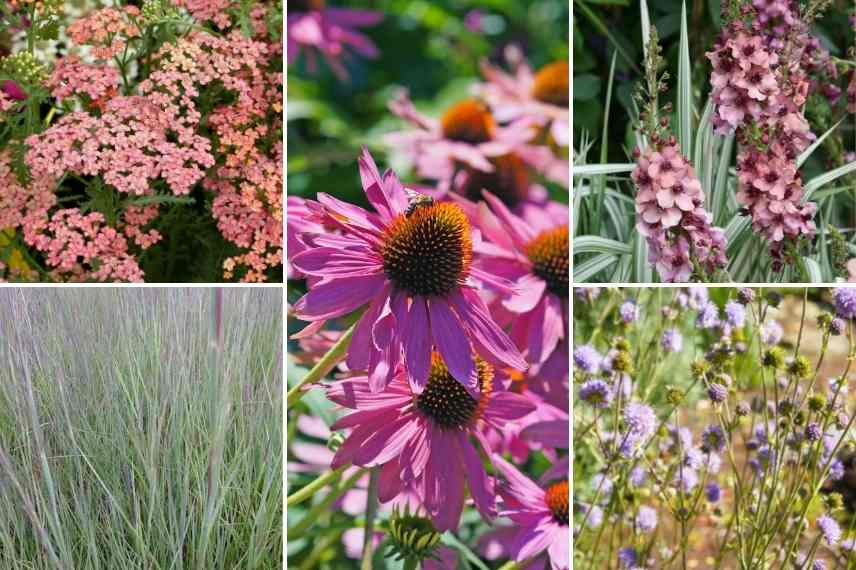
Yarrow, Schizachyrium scoparium, Echinacea purpurea, Verbascum ‘Southern Charm’, and Knautias arvensis[/caption>
The Water Garden or Pond
Cool or moist grounds can host a beautiful palette of pink flowers, which will make a statement whether planted at the pond’s edge or submerged in the case of iconic water lilies (Nymphaea). Combine Eupatoriums, Physostegias, Astilbes or pink or white Filipendulas and Schizostylis, with exceptional foliage like Colocasias, Rodgersias and other Farfugiums. Don’t forget some more vertical grasses like Acorus, the graphic form of Thalia dealbata, and the elegance of water Iris. Pink blooms will pair very well with the pink inflorescences of Darmera peltata, white Lysimachias, or blue, even yellow in this bank context.
[caption id="attachment_146496" align="aligncenter" width="856"]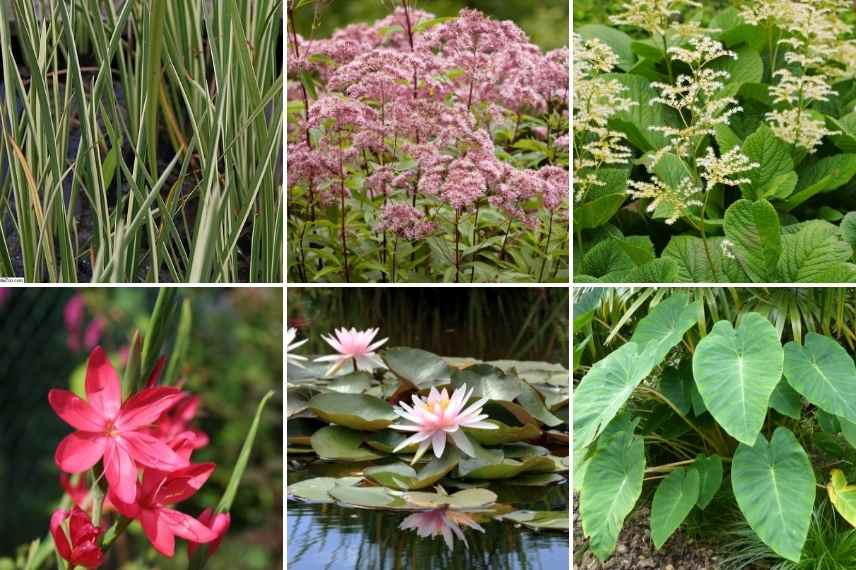 Acorus calamus, Eupatoriums, Rodgersia, Schizostylis, Nymphaea, and Colocasia,
Acorus calamus, Eupatoriums, Rodgersia, Schizostylis, Nymphaea, and Colocasia,
Associating pink flowers with different seasons
Spring
Spring and its festival of fresh colours is a beautiful season to combine pink flowers, as they all pair very well together and rarely suffer from poor taste.
Many bulbous perennials allow for lovely fresh combinations: pink tulips and blue muscaris or myosotis, tulips in a vibrant mix of pink, orange, and purple, Crocus tommasinianus and yellow or white crocuses. Mass-planted tulips lend themselves well to the extravagance of often very successful colourful assortments; pink dragée tulips pair beautifully with pale yellow tulips or daffodils, Japanese primroses with the velvety foliage of hostas, Magnolia soulangeana or Japanese quinces with a carpet of purple or light green heucheras and apricot tulips… After all, it’s all a matter of taste and the plants already existing in your garden…
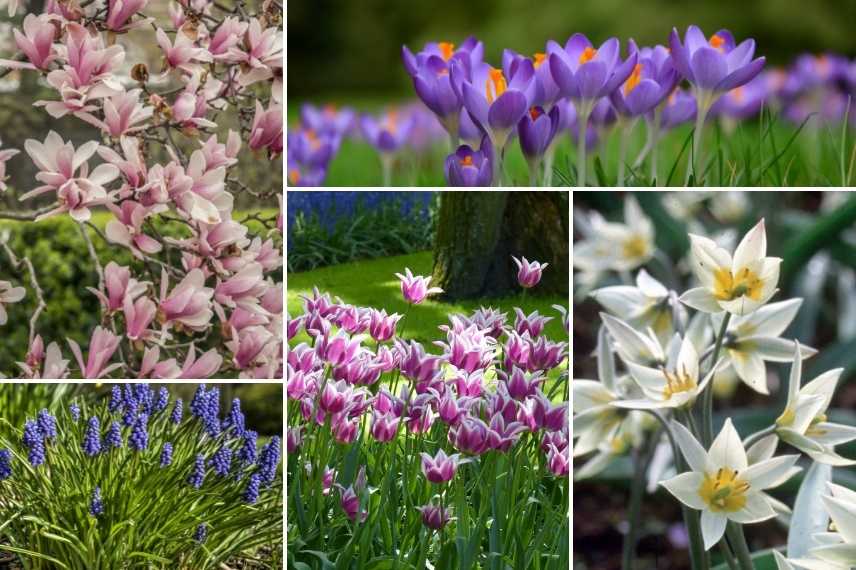 Magnolia soulangeana, crocus tommasinianus, muscaris, Tulip ‘Ballade’ and Turkestan tulips
Magnolia soulangeana, crocus tommasinianus, muscaris, Tulip ‘Ballade’ and Turkestan tulips
Summer
Along with spring, it’s the other season where pink flowers fully express themselves in the garden, as pink flowers number in the hundreds, from large shrubs like oleander to small perennials like Delospermas… You can more easily create warm and vibrant flower beds by pairing bright pink flowers with intense oranges, purples, and yellows, or conversely, very soft and bucolic scenes by mixing pink flowers with light shades, white, as well as pale purple, very soft blues, and the grey of sunlit foliage. You can also create contrasts between the deep purple of Cotinus or Berberis, for example, with the soft pink of Veronicastrums and Thalictrums, or the apricot pinks of avens or potentillas. It’s summer… indulge in a riot of pinks!
 Achillea purpurea, Hydrangeas ‘Annabelle’, pink Gaura, lavender, and potentilla
Achillea purpurea, Hydrangeas ‘Annabelle’, pink Gaura, lavender, and potentilla
Autumn
Pink flowers are still very numerous at the end of summer and in autumn. Besides Sedums, colchicums, and Asters that fully bloom at this time, Japanese anemones and Lagerstroemias extend the season, while some hydrangeas take on sublime pink hues, and Nerines and Chrysanthemums make their appearance. Other pink flowers are present late in the garden: Gauras, Dahlias, cosmos, and some interesting shrubs like Camellias sasanqua, Heptacodium, Abelias and Arbutus unedo…
There’s plenty to think about when it comes to combining all these wonders of often faded pink. Focus mainly on the existing foliage that will take on warm hues, such as Euonymus alatus with raspberry to purple colours, Cotinus or certain Japanese maples, as well as grasses at their peak. Pink to purple cordylines or phormiums are also beautifully enhanced at this time, and all evergreen foliage, green, golden, or bronze, planted alongside will reveal these last pink blooms. A few touches of white flowers will be welcome for a few more weeks of softness…
 Heptacodium miconioides, Phormium, Dahlias, Miscanthus sinensis ‘Krater’ and winged euonymus
Heptacodium miconioides, Phormium, Dahlias, Miscanthus sinensis ‘Krater’ and winged euonymus
Winter
A few pink flowers appear in the middle of winter: among them are perennials like hellebores and cyclamens, shrubs and bushes like heathers and daphnes, the essential Viburnum bodnantense and Prunus subhirtella ‘Automnalis Rosea’. While they are few in number, they are enough to amaze us.
These pink blooms will be particularly highlighted with white flowers, often found among winter hellebores and heathers, but also Nivéoles, cyclamens, and anemones nemorosa. The all-white Edgeworthia, tinged with yellow, also enjoys the company of pink flowers, those of hellebores and daphnes that will illuminate the garden until spring arrives. In reality, very pale yellow shades pair well in winter with the softness of pink blooms, such as white forsythia or corylopsis. Just as much as white, they bring a necessary light to the garden. Finally, the reddened or orange woods of dogwoods prove to be a more vibrant option for your flower beds! Also invite the foliage of evergreen ferns, sacred bamboos, conifers, and heucheras, along with the white bark of birches or the shiny bark of Prunus.
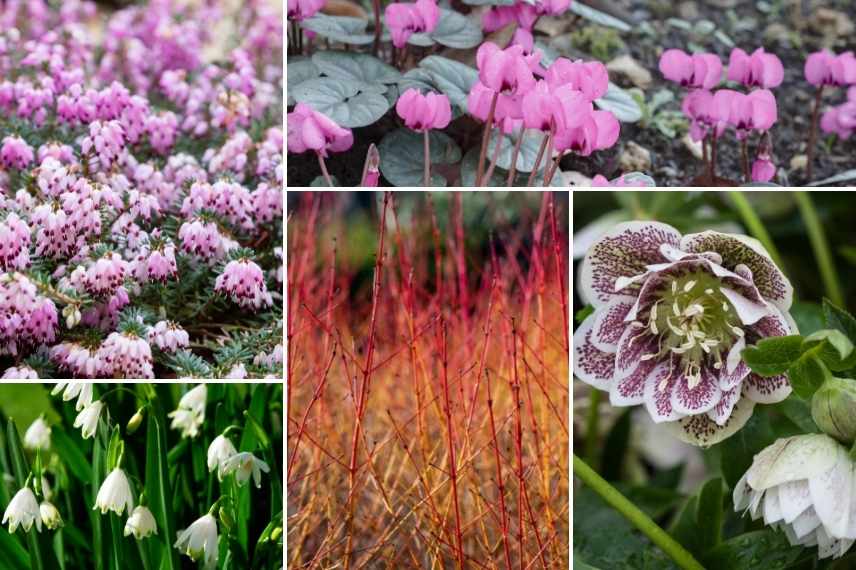 Erica darleysensis, Cyclamen coum, Nivéoles, Cornus alba ‘Sanguinea’ and oriental hellebores
Erica darleysensis, Cyclamen coum, Nivéoles, Cornus alba ‘Sanguinea’ and oriental hellebores
- Subscribe!
- Contents
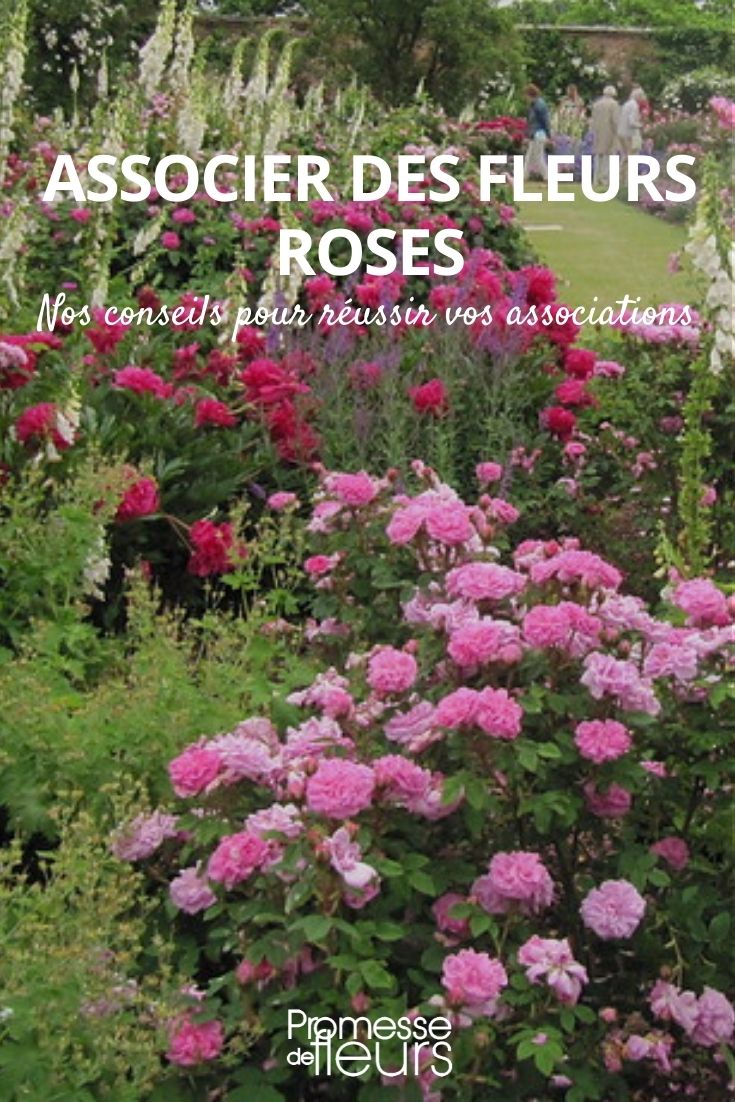


































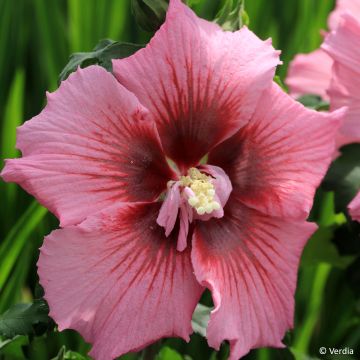
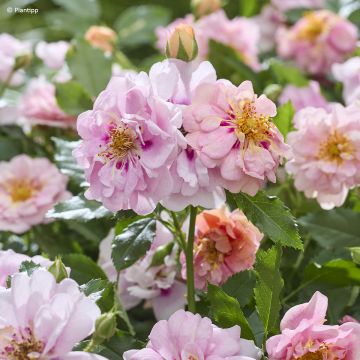
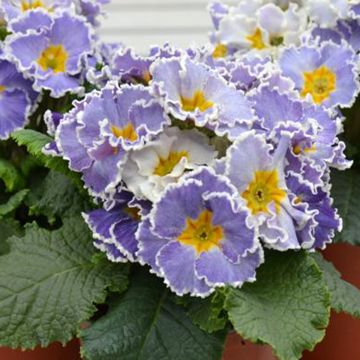
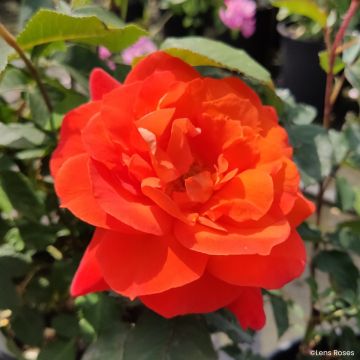
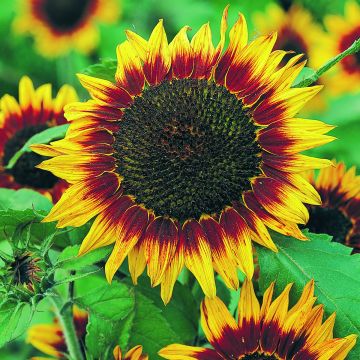
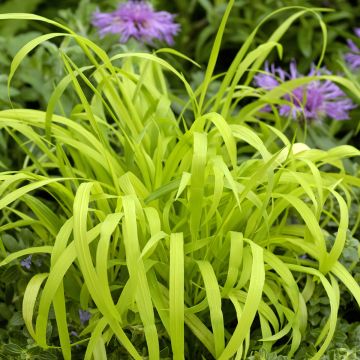
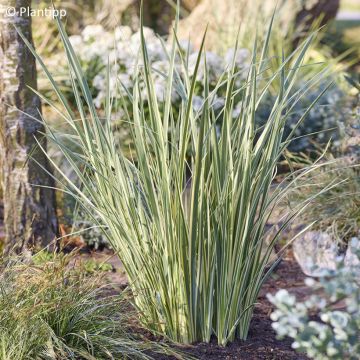
Comments